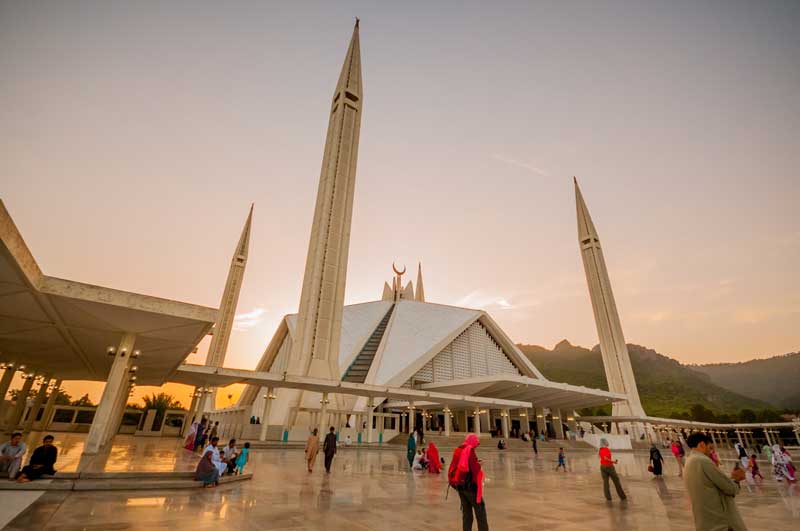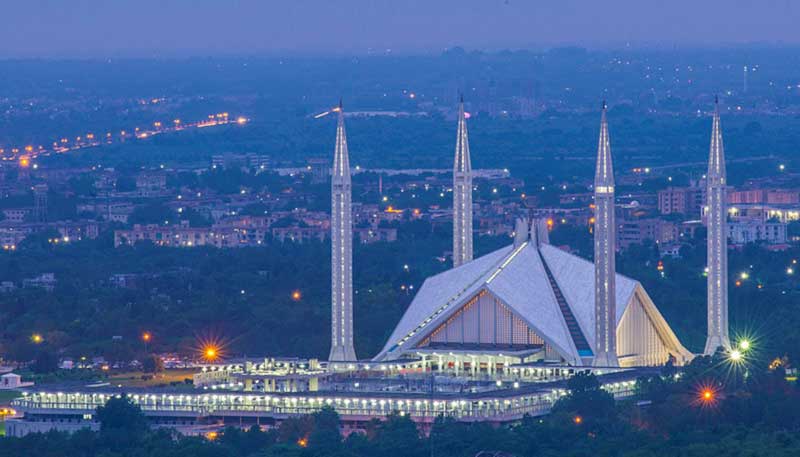
Nestled at the foot of Margalla Hills, the westernmost foothills of the Himalayas and situated at the north end of Faisal Avenue in the capital city of Islamabad, Pakistan, the stunning Faisal Mosque is reckoned as the sixth-largest mosque in the world and one of the most popular and historically significant tourist attractions in the country. Named after its benefactor Faisal bin Abdulaziz Al Saud, who allotted a colossal grant of $120 million for the construction of a mosque in Pakistan during his visit in the country in 1966, Faisal Mosque was designed by the Turkish architect Vedat Dalokay, who was selected after winning an international competition, in which architects from 17 countries submitted 43 proposals.
However, the project was delayed, as the Saudi king was assassinated in March 1975 in Riyadh and the foundation of the building could only be laid a year later by his successor, King Khalid bin Abdulaziz. Located on an elevated area of land against a picturesque backdrop of the national park, the design of the Faisal Mosque is unusual and revolutionary, as it is devoid of the usual domes and arches, like most of the other mosques around the world.

With forty-six acres of land assigned to the project, the construction of the Faisal Mosque, funded by the government of Saudi Arabia, began by National Construction Limited of Pakistan, when King Khalid, the successor of King Khalid bin Abdulaziz laid the foundation stone for the mosque in October 1976. Although the mosque was completed in 1986, the first prayer was held only on 18 June 1988. The mosque is made up of white marble, but unlike traditional mosques around the world, the Faisal Mosque is not supported by any domes or arches. Covering an area of 54,000 square feet (5,000 sq m), the mosque is shaped like a Bedouin tent, surrounded by four giant 260 feet (79 m) tall minarets, the tallest minarets in South Asia, built on its four external corners, while the eight-sided shell shaped sloping roofs formed a triangular worship hall which can accommodate 10,000 worshippers.
The eight-sided main hall of the mosque took its inspiration from Arabic culture, but the tall and beautiful minarets clearly reflect Turkish architecture, while the mosque is crowned with a unique gold-plated copper crescent-shaped finial accompanying the imagery of the minarets.

Although the pitched roof of the Faisal Mosque is based on a pyramidal form, its lower part has a gable roof structure, influenced by Greek architecture and the sloping lines at the corners are inspired by the pyramidal roof.
With every joining of the slanting triangular slab making a gable point, the design formed by the various sizes of white marble covering the roof panel is visible from a distance, producing a soft impression of a network of vertical and horizontal lines.


The Faisal Mosque, built with the capacity to accommodate about 300,000 worshippers, is akin to the Holy Kaaba in the imaginative eyes of the designer. The four walls of the building, adorned with different decorative designs, are placed in the form of isosceles triangles whose base is 215 feet and a terrace of about 13 feet above the floor level of the northern court is attached to the north wall, surrounded by a low wall of 3 feet 6 inches high. The floor of the terrace is paved with grey granite that contrasts with the white colour of the mosque. The main entrance, located in the east of the sanctuary and fronted by a courtyard with porticoes, is further divided into nine vertical sections made of concrete and filled with crescent motifs.

The interior of the main tent-shaped hall is covered in white marble and decorated with colourful mosaics and calligraphy by the famous Pakistani artist Sadequain, along with a Turkish-style chandelier. The west wall of the mosque features a mosaic pattern on which Kalimah, the formal declaration of faith often recited by the Muslims, is written in the early Kufic script, repeated in a mirror image effect and the Qibla Wall is covered with blue and white calligraphic tiles designed by a Turkish artist Mengu Ertel.

Although harshly criticized by some traditional and conservative Muslims at the initial stage for its unconventional design and lack of a traditional dome structure, the Faisal Mosque also used to house the International Islamic University some years ago, but has since relocated to a new campus in 2000. Regarded as a gorgeous piece of Islamic architecture and a major tourist attraction in Pakistan, today it has also become a national symbol of Pakistan, a cross-cultural symbol, representing the ambition, expectation and inspiration of the people of the country.
Although harshly criticized by some traditional and conservative Muslims at the initial stage for its unconventional design and lack of a traditional dome structure, the Faisal Mosque also used to house the International Islamic University some years ago, but has since relocated to a new campus in 2000. Regarded as a gorgeous piece of Islamic architecture and a major tourist attraction in Pakistan, today it has also become a national symbol of Pakistan, a cross-cultural symbol, representing the ambition, expectation and inspiration of the people of the country.